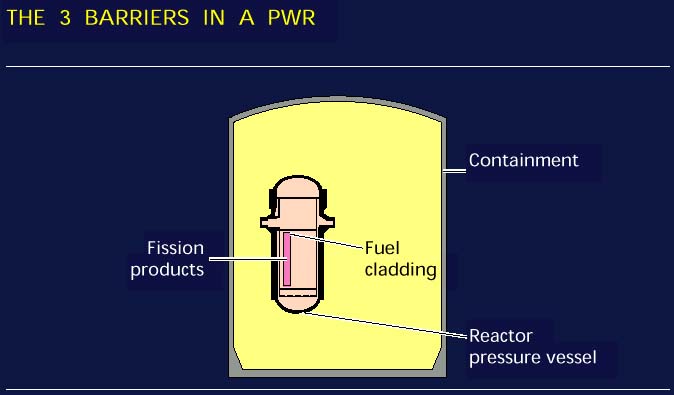
Containment
A key principle in the design of the nuclear plant is defense in depth. Nuclear plants (all types) are designed with 3 barriers between the radioactive fission products and the public in order to reduce the likelihood of radioactive releases. These 3 barriers are - the fuel cladding, the reactor pressure vessel or coolant piping, and the containment. The figure below illustrates this concept.

Courtesy EdF
The containment is a large steel building, usually with a hemispherical dome. Containments are often not visible since they are usually surrounded by a steel or concrete building that provides additional boundaries and aesthetically pleasing designs.
The containment is capable of sustaining high internal pressures. Design is in the range of 45 to 60 psig, however, much higher pressures, even exceeding 100 psig may be sustained. Ice condenser containments are smaller and have lower design pressures - approximately 12 psig. In either case, the containment is designed for a double ended rupture of the largest diameter pipe in the structure. These pipes are usually 3 feet in diameter.
The containment houses the reactor, reactor cooling or recirculation system and pumps. For PWRs, the pressurizer is also in the containment.
Containments have fans or chiller units for cooling during normal conditions and in the unlikely event of an accident. To provide additional cooling and pressure suppression, several ring headers are mounted in the uppermost part of the containment. These ring headers are used to spray water (often borated) to reduce pressure.
Sumps located below the containment basement may be used as a water source during accident conditions. The sumps are routed to cooling systems so that the fluid may be recirculated and cooled. A grating system is installed over the sump to prevent materials from being sucked into the cooling system, usually called the Residual Heat Removal system.
Copyright © 1996-2004. Joseph Gonyeau, P.E.. The Virtual Nuclear Tourist. All rights reserved. Revised: March 15, 2001.